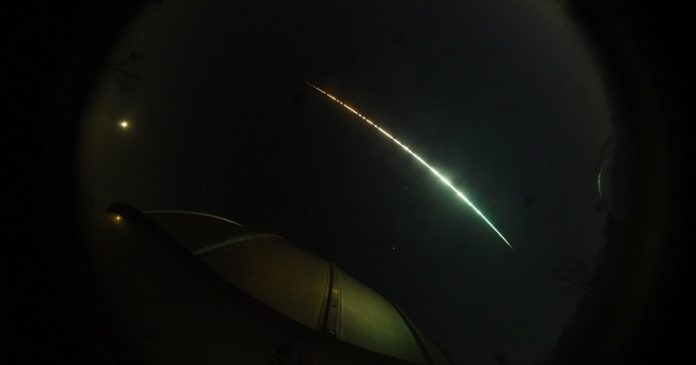
In an extraordinary study, scientists from Western University and Lowell Observatory have revealed the details of a small asteroid, 2022 WJ1, which exploded over the Niagara region in November 2022.
The event offered a rare opportunity to study an asteroid both in space and as it entered Earth’s atmosphere, marking the first time such a comprehensive approach has been used.
The study, published in The Planetary Science Journal, not only describes 2022 WJ1—the smallest asteroid to ever be characterized—but also demonstrates a groundbreaking method for studying near-Earth objects that could help protect Earth from future impacts.
Asteroid 2022 WJ1 was first spotted by the Catalina Sky Survey in Arizona just three hours before it was predicted to enter Earth’s atmosphere.
This short warning period allowed astronomers to quickly observe the asteroid using the Lowell Discovery Telescope (LDT) in Arizona.
At just 40–60 cm (16–27 inches) in diameter, it is the smallest asteroid ever studied in this way.
The LDT’s observations revealed that 2022 WJ1’s surface was rich in silica, a material that reflects light. This high reflectivity helped scientists determine the asteroid’s size. As the asteroid approached Earth, it lit up the night sky as a fireball—a bright meteor—captured by Western University’s network of meteor cameras across Southern Ontario.
“This is only the sixth asteroid ever discovered before it hit Earth,” said Denis Vida, a physics and astronomy professor at Western. “Using both space telescopes and ground cameras allowed us to confirm the asteroid’s size and composition with incredible accuracy.”
Combining data from telescopes and meteor cameras is a first in asteroid research. The LDT observed the asteroid in space, while Western’s meteor camera network captured it as it burned up in the atmosphere over the Great Lakes.
Both methods produced consistent results, showing that the asteroid had a stony composition and likely belonged to the S-chondrite class of space rocks. S-chondrites are rich in silica and are some of the oldest materials in the solar system. They are also the most common type of meteorite to fall to Earth.
“This collaboration is incredibly exciting because it means we’ll be able to study future asteroids in even greater detail,” said Teddy Kareta, a postdoctoral researcher at Lowell Observatory.
The asteroid’s predicted path proved to be incredibly lucky. It entered Earth’s atmosphere over the Great Lakes region, right in the middle of Western University’s camera network. This allowed scientists to track its journey in detail.
Paul Wiegert, a professor at Western University, watched the fireball streak across the sky from Brescia Hill on campus. “It was cold and windy, but the view was clear,” he said. “The fireball appeared suddenly, glowing orange-red as it passed overhead.”
Meanwhile, the LDT in Arizona was able to keep pace with the fast-moving asteroid thanks to its advanced tracking capabilities. Kareta and his team imaged the asteroid for an hour before it became too dim to see.
Although most of 2022 WJ1 burned up in the atmosphere, scientists believe fragments may have survived the fall to Earth. However, initial searches in the Niagara region have turned up empty-handed. Much of the predicted fall zone lies underwater in Lake Ontario, and any fragments on land have likely blended into the environment.
“Two years on, any meteorites on land will be very hard to find,” said Phil McCausland, a researcher at Western. “Still, some people in the area are searching, and we may yet find pieces in the future.”
This study is only the second time an asteroid has been studied with telescopes before hitting Earth. The success of this effort highlights the growing collaboration among scientists to better understand and monitor near-Earth objects.
“It’s amazing how everything aligned—clear skies in Arizona, Western’s camera network in place, and scientists ready to observe,” said Kareta. “It’s a perfect example of how preparation and teamwork can lead to groundbreaking discoveries.”
This pioneering approach will help researchers characterize future asteroids more precisely, improving our ability to predict and prepare for potential impacts. For now, 2022 WJ1 stands as a shining example of what science can achieve when luck, technology, and teamwork come together.



